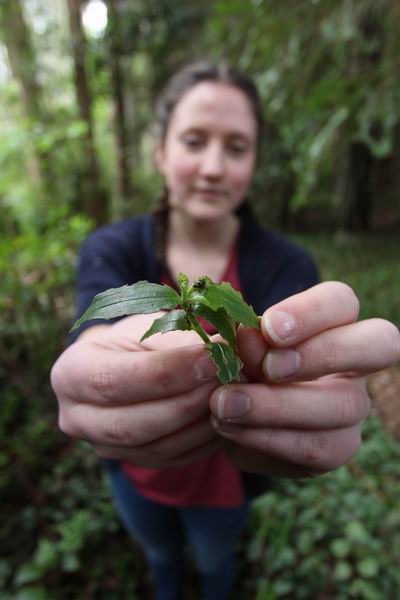Kerikeri student’s ‘world-first’ beetle research impresses
12 Sep 2016, 1:40 PM
A Kerikeri teenager’s ‘world-first’ research is shedding new light on a Brazilian leaf beetle specially introduced into Northland several years ago as a biocontrol for tradescantia, one of the region’s most problematic pest plants.
Aimee Leaming took out a Northland Regional Council excellence award at the recent Far North Science and Technology Fair for her work, a lengthy investigation into a range of factors influencing the survival and feeding rates of Neolema ogloblini or tradescantia leaf beetles.
The 17-year-old, a Year 13 student at Kerikeri High School, investigated light intensity and temperature preferences, as well as establishing a population of the beetles in Kerikeri.
 Tradescantia leaves damaged by the biocontrol beetle.
Tradescantia leaves damaged by the biocontrol beetle.
Tradescantia, also known as ‘wandering jew’, is a hardy, shade-tolerant pest plant which has long been a problem in Northland’s relatively mild, semi-tropical climate.
It’s an issue because it forms thick blankets that can rapidly smother and exclude virtually all other plant species. New Zealand is understood to be the first country in the world to introduce tradescantia beetles – which feed on it – to use as a biocontrol.
Aimee’s work – including a series of intricate dissections of the tiny insects – showed that while they are probably ideally suited to the Northland climate, they may struggle in cooler parts of New Zealand.
Cable Bay-based entomologist Jenny Dymock, who works with the regional council, says Aimee’s research is impressive and has potentially international implications for those seeking to use the beetle as a biocontrol.
Aimee’s observations – including the beetle’s apparent fondness for dappled light – had given valuable insights that would be especially useful for researchers when deciding where to release the beetles in the future.
Aimee says the relative lack of information about the beetles is probably because in their native Brazil, tradescantia weed is not invasive, so the beetles had not been seriously researched.
And most of the research done by New Zealand scientists over several years before the beetle’s 2011 release in Northland had been to make sure it was host-specific (a crucial requirement for use as a biocontrol) and posed no risk to other plant species.
However, Aimee says the fact relatively little else was known about the beetles – other than that they seemed to be able reduce the growth of tradescantia – is what had triggered her interest in the first place.
The first Northland releases five years ago had involved tradescantia leaf beetles, informally known to researchers as ‘shiny’ due to their dark metallic bronze colour and slight iridescence.
Aimee’s research had focused on the ‘shiny’ beetle, however, since 2011, two more tradescantia beetle species, a stem borer nicknamed ‘knobbly’ and a tip feeder dubbed ‘stripey’ (again due to their respective markings) had also been released in Northland.
Dr Dymock says biocontrols like the three tradescantia beetle species offer cost-effective forms of pest control, which don’t require the use of herbicides or other chemicals.
“While biocontrols aren’t in themselves a ‘magic bullet’ solution to pest species, they’re a smart tool for today’s world.”
She says there are currently a number of biocontrol agents at work in Northland including insects, fungi and rusts which attack a variety of pest plants and insects including tropical grass webworm, mistflower, gorse, ragwort and tobacco weed.
People interested to learn more about the regional council’s biocontrol programme should visit www.nrc.govt.nz/nasties
